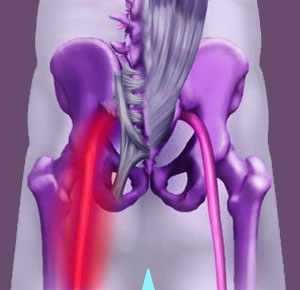
Unilateral piriformis pain is more common than bilateral symptoms. However, demonstrating piriformis pain in one leg does increase the chance of suffering it in the other leg, as well, either simultaneously or at some point in the future. Of course, you must have surmised already that unilateral pain means symptomology that exists in only one side of the body or in one leg. Since there are 2 piriformis muscles in the human anatomy, patients can experience symptoms on the left or right side with unilateral expressions or on both sides of the body in bilateral piriformis pain syndromes.
This treatise delves into unilateral expressions in the piriformis including injury, RSI, muscle imbalances and the often enigmatic condition known as piriformis syndrome.
Unilateral Piriformis Pain Locations
Piriformis symptoms in one leg can exist in any of the usual locations anatomically, depending on the nature of the causative process. Within the piriformis muscle itself, pain may exist deep in the buttocks, near the sacroiliac joint or seemingly in the hip region. The piriformis muscle stretches across several noted locations inside the body and pain syndromes located in the muscle itself are often difficult to pinpoint in terms of exact location. This is why so many patients suffer misdiagnosis of piriformis, hip, SIJ and lower back issues.
Pain, tingling, numbness and weakness might be present outside of the piriformis anatomy. Typically, these symptoms will reside in the upper, rear aspect of the leg or the upper outer aspect of the leg. Less commonly, pain will reside in the frontal thigh, the outer knee or the outer and rear aspects of the calf muscle. In the least often seen clinical expressions, pain might radiate all the way in the foot, possibly affecting numerous locations. All of these symptoms are characteristic of the pseudosciatica expressions created by piriformis syndrome.
In rare instances of pudendal nerve involvement, pain and other neurological expressions might exist near the anus, in the perineum, in the pelvis, in the groin or in the genitals.
Unilateral Piriformis Syndrome Diagnosis
Unilateral piriformis conditions can fall into various diagnostic classifications including any of the following common scenarios:
Injury can occur to the piriformis muscle on one side of the body due to trauma, athletic strain or other occurrence. Injury might affect the piriformis muscle fibers or any of the attaching tendons that secure the muscle to its various attachment points. Injury might cause spasms and also lead to piriformis syndrome.
RSI is a disorder created by repetitive strain on the muscle resulting in the accumulation of damage and scarring that affects functionality. RSI is a diagnosis on the rise, despite much evidence that many cases are incorrectly identified.
Muscular imbalances can affect the piriformis muscle or any of the lateral rotator group of tissues unilaterally. Muscular imbalances can create hyper-lax and hyper-taut muscles, both of which can be problematic in rare instances.
Piriformis syndrome describes compression of the sciatic and/or pudendal nerves by the piriformis muscle.
Unilateral Piriformis Pain Factsheet
Any unilateral piriformis problem has the potential to throw off the balance in the lower body, due to functional deficits and the body’s natural compensatory reactions to pain. This is the reason why stress is increased on the other side of the body, which often bears the brunt of strain and weight bearing for as long as the painful side remains symptomatic. This explains why it is commonplace for pain to develop in the other side, as well.
However, there is another common explanation as to why symptoms tend to move and migrate. Doctors who practice mindbody medicine cite the virtually universal tendency for psychosomatic and psychogenic pain to move about for many reasons, including response to treatment, the desire for more conscious attention or in reaction to a cure that is often enacted by some powerful placebo treatment, such as surgery. We find much support for this theory, since the mindbody pain conditions we see on a daily basis mirror these actions of movement. We also find a large proportion of post-operative piriformis pain sufferers who were cured using surgery, yet eventually develop virtually identical painful complaints in the other side of the body, often resulting in additional surgery, followed by the growth of new symptoms elsewhere. This is proof positive of the power of the psychological symptom imperative and the exact reason why mindbody pain syndromes should never be treated with physical modalities. The only way to resolve them for good is with the application of knowledge therapy.
Piriformis Pain > Piriformis Syndrome > Unilateral Piriformis Pain





